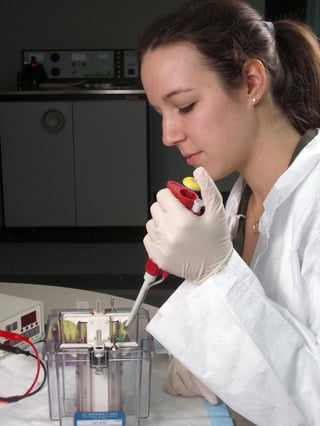 SDS-PAGE (sodium dodecyl sulfate polyacrylamide gel electrophoresis) is a common laboratory technique in which proteins are separated by their size by running the proteins through a polyacrylamide matrix by applying an electrical field across the matrix. A native gel electrophoresis is when there aren’t any detergents present while running the assay. This means that the factors affecting the rate of migration for proteins in a native gel electrophoresis assay are the protein’s molecular radius and total net charge across the protein. The molecular radius is determined by the complex tertiary structure and the net charge is the sum of all the positive and negative charges across all the protein’s amino acids. While native gel electrophoresis has its uses, it can be very challenging to interpret, proteins can migrate to either of the electrodes and can separate variably based on their tertiary shape. For these reasons most electrophoresis assays are run with some detergent present (usually SDS) so that only one factor (protein size) influences the rate of migration.
SDS-PAGE (sodium dodecyl sulfate polyacrylamide gel electrophoresis) is a common laboratory technique in which proteins are separated by their size by running the proteins through a polyacrylamide matrix by applying an electrical field across the matrix. A native gel electrophoresis is when there aren’t any detergents present while running the assay. This means that the factors affecting the rate of migration for proteins in a native gel electrophoresis assay are the protein’s molecular radius and total net charge across the protein. The molecular radius is determined by the complex tertiary structure and the net charge is the sum of all the positive and negative charges across all the protein’s amino acids. While native gel electrophoresis has its uses, it can be very challenging to interpret, proteins can migrate to either of the electrodes and can separate variably based on their tertiary shape. For these reasons most electrophoresis assays are run with some detergent present (usually SDS) so that only one factor (protein size) influences the rate of migration.
Detergents are amphipathic compounds with a nonpolar, hydrophobic tail and a polar, hydrophilic head group. Due to these structural features detergents tend to aggregate into structures called micelles at high enough concentration; arranging themselves with their hydrophobic tails pointed inwards and their hydrophilic heads pointed outwards. Detergents come in three types: ionic (cationic and anionic) and non-ionic. Non-ionic detergents aren’t generally used for gel electrophoresis due to their limited ability to break non-covalent interactions between a protein’s amino acids and inability to impart a uniform charge onto the protein. Ionic detergents (such as anionic SDS) are used for gel electrophoresis as they are highly useful for protein solubilization, linearization and for establishing a uniform charge in preparation for gel electrophoresis.
Proteins consist of stretches of hydrophilic and hydrophobic amino acids which generally fold in such a way that hydrophobic amino acids are buried in the interior of the protein and hydrophilic amino acids are on the exterior of the protein. This tendency of proteins allows for cytoplasmic proteins to dissolve into the aqueous environment of the cell, but membrane proteins which typically have exposed hydrophobic sites that allow them to bind to or integrate into the lipid bilayer of the cell, are not typically readily soluble. It is, therefore, the detergent’s job to assist in denaturing the protein and by doing so increase its solubility. The hydrophobic tail of a detergent stabilizes any hydrophobic amino acids present in the protein and the hydrophilic head disrupts any non-covalent bonds between amino acids to unfold the protein.
That’s not all detergents are responsible for in gel electrophoresis; they are also responsible for imparting a uniform charge across the length of the protein. Ionic detergents act by masking the differing charges across all proteins in solution by applying a comparatively much larger net negative (in the case of an anionic detergent) charge across the whole of the protein. Furthermore, detergents interfere with any non-covalent interactions between individual amino acids in the protein thereby reducing the globular protein to a linear chain of amino acids. By doing this all of the proteins in the sample will have essentially a uniform charge and all migrate at the same rate with respect to their charge, thus allowing only the size of the protein to be the separating factor.
Here's some more related blogs:






